Introduction to LightDB-A
High-level overview of the LightDB-A Database system architecture.
LightDB-A Database stores and processes large amounts of data by distributing the load across several servers or hosts. A logical database in LightDB-A is an array of individual PostgreSQL databases working together to present a single database image. The coordinator is the entry point to the LightDB-A Database system. It is the database instance to which users connect and submit SQL statements. The coordinator coordinates the workload across the other database instances in the system, called segments, which handle data processing and storage. The segments communicate with each other and the coordinator over the interconnect, the networking layer of LightDB-A Database.
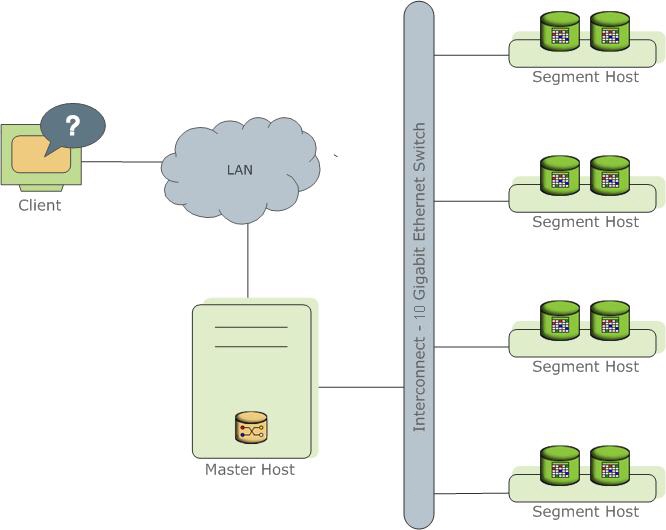
LightDB-A Database is a software-only solution; the hardware and database software are not coupled. LightDB-A Database runs on a variety of commodity server platforms from LightDB-A-certified hardware vendors. Performance depends on the hardware on which it is installed. Because the database is distributed across multiple machines in a LightDB-A Database system, proper selection and configuration of hardware is vital to achieving the best possible performance.
This chapter describes the major components of a LightDB-A Database system and the hardware considerations and concepts associated with each component: The LightDB-A Coordinator, The Segments and The Interconnect. Additionally, a system may have optional ETL Hosts for Data Loading and VMware LightDB-A Performance Monitoring for monitoring query workload and performance.
Parent topic: Installing and Upgrading LightDB-A
The LightDB-A Coordinator
The coordinator is the entry point to the LightDB-A Database system. It is the database server process that accepts client connections and processes the SQL commands that system users issue. Users connect to LightDB-A Database through the coordinator using a PostgreSQL-compatible client program such as psql or ODBC.
The coordinator maintains the system catalog (a set of system tables that contain metadata about the LightDB-A Database system itself), however the coordinator does not contain any user data. Data resides only on the segments. The coordinator authenticates client connections, processes incoming SQL commands, distributes the work load between segments, coordinates the results returned by each segment, and presents the final results to the client program.
Because the coordinator does not contain any user data, it has very little disk load. The coordinator needs a fast, dedicated CPU for data loading, connection handling, and query planning because extra space is often necessary for landing load files and backup files, especially in production environments. Customers may decide to also run ETL and reporting tools on the coordinator, which requires more disk space and processing power.
Parent topic: Introduction to LightDB-A
Coordinator Redundancy
You may optionally deploy a backup or mirror of the coordinator instance. A backup coordinator host serves as a warm standby if the primary coordinator host becomes nonoperational. You can deploy the standby coordinator on a designated redundant coordinator host or on one of the segment hosts.
The standby coordinator is kept up to date by a transaction log replication process, which runs on the standby coordinator host and synchronizes the data between the primary and standby coordinator hosts. If the primary coordinator fails, the log replication process shuts down, and an administrator can activate the standby coordinator in its place. When the standby coordinator is active, the replicated logs are used to reconstruct the state of the coordinator host at the time of the last successfully committed transaction.
Since the coordinator does not contain any user data, only the system catalog tables need to be synchronized between the primary and backup copies. When these tables are updated, changes automatically copy over to the standby coordinator so it is always synchronized with the primary.
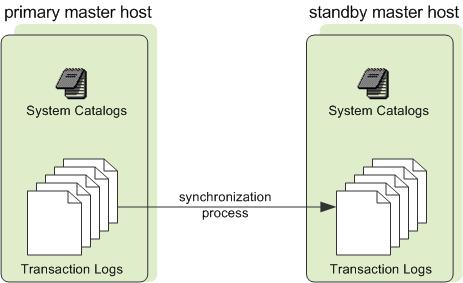
The Segments
In LightDB-A Database, the segments are where data is stored and where most query processing occurs. User-defined tables and their indexes are distributed across the available segments in the LightDB-A Database system; each segment contains a distinct portion of the data. Segment instances are the database server processes that serve segments. Users do not interact directly with the segments in a LightDB-A Database system, but do so through the coordinator.
In the reference LightDB-A Database hardware configurations, the number of segment instances per segment host is determined by the number of effective CPUs or CPU core. For example, if your segment hosts have two dual-core processors, you may have two or four primary segments per host. If your segment hosts have three quad-core processors, you may have three, six or twelve segments per host. Performance testing will help decide the best number of segments for a chosen hardware platform.
Parent topic: Introduction to LightDB-A
Segment Redundancy
When you deploy your LightDB-A Database system, you have the option to configure mirror segments. Mirror segments allow database queries to fail over to a backup segment if the primary segment becomes unavailable. Mirroring is a requirement for VMware-supported production LightDB-A systems.
A mirror segment must always reside on a different host than its primary segment. Mirror segments can be arranged across the hosts in the system in one of two standard configurations, or in a custom configuration you design. The default configuration, called group mirroring, places the mirror segments for all primary segments on one other host. Another option, called spread mirroring, spreads mirrors for each host’s primary segments over the remaining hosts. Spread mirroring requires that there be more hosts in the system than there are primary segments on the host. On hosts with multiple network interfaces, the primary and mirror segments are distributed equally among the interfaces. Figure 2 shows how table data is distributed across the segments when the default group mirroring option is configured.
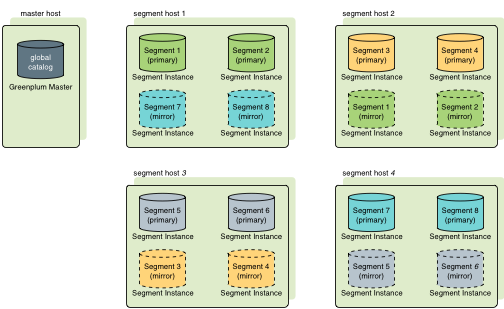
Segment Failover and Recovery
When mirroring is enabled in a LightDB-A Database system, the system automatically fails over to the mirror copy if a primary copy becomes unavailable. A LightDB-A Database system can remain operational if a segment instance or host goes down only if all portions of data are available on the remaining active segments.
If the coordinator cannot connect to a segment instance, it marks that segment instance as invalid in the LightDB-A Database system catalog. The segment instance remains invalid and out of operation until an administrator brings that segment back online. An administrator can recover a failed segment while the system is up and running. The recovery process copies over only the changes that were missed while the segment was nonoperational.
If you do not have mirroring enabled and a segment becomes invalid, the system automatically shuts down. An administrator must recover all failed segments before operations can continue.
Example Segment Host Hardware Stack
Regardless of the hardware platform you choose, a production LightDB-A Database processing node (a segment host) is typically configured as described in this section.
The segment hosts do the majority of database processing, so the segment host servers are configured in order to achieve the best performance possible from your LightDB-A Database system. LightDB-A Database’s performance will be as fast as the slowest segment server in the array. Therefore, it is important to ensure that the underlying hardware and operating systems that are running LightDB-A Database are all running at their optimal performance level. It is also advised that all segment hosts in a LightDB-A Database array have identical hardware resources and configurations.
Segment hosts should also be dedicated to LightDB-A Database operations only. To get the best query performance, you do not want LightDB-A Database competing with other applications for machine or network resources.
The following diagram shows an example LightDB-A Database segment host hardware stack. The number of effective CPUs on a host is the basis for determining how many primary LightDB-A Database segment instances to deploy per segment host. This example shows a host with two effective CPUs (one dual-core CPU). Note that there is one primary segment instance (or primary/mirror pair if using mirroring) per CPU core.
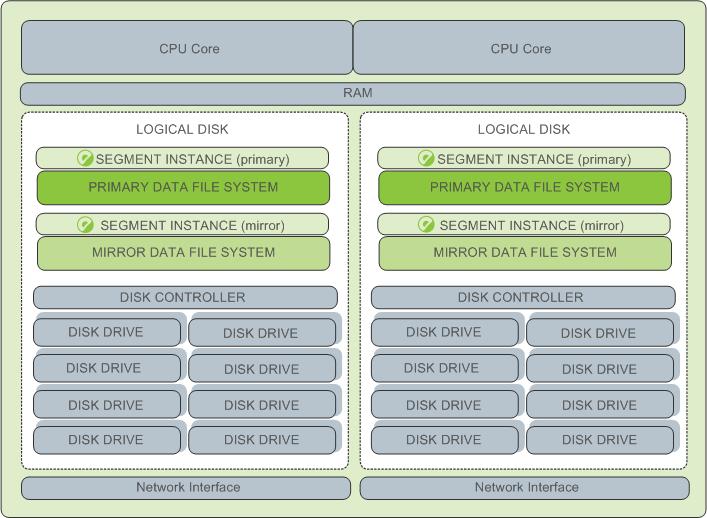
Example Segment Disk Layout
Each CPU is typically mapped to a logical disk. A logical disk consists of one primary file system (and optionally a mirror file system) accessing a pool of physical disks through an I/O channel or disk controller. The logical disk and file system are provided by the operating system. Most operating systems provide the ability for a logical disk drive to use groups of physical disks arranged in RAID arrays.
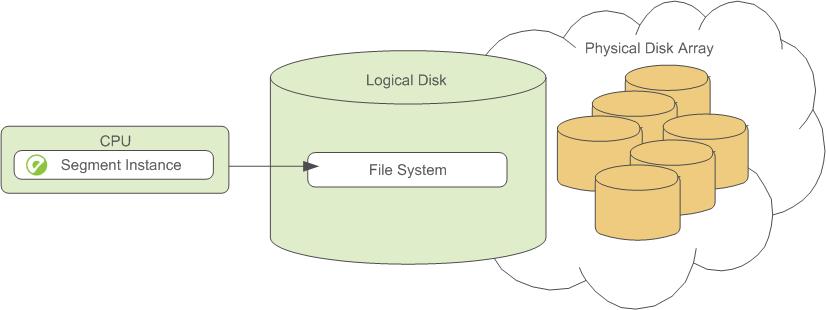
Depending on the hardware platform you choose, different RAID configurations offer different performance and capacity levels. LightDB-A supports and certifies a number of reference hardware platforms and operating systems. Check with your sales account representative for the recommended configuration on your chosen platform.
The Interconnect
The interconnect is the networking layer of LightDB-A Database. When a user connects to a database and issues a query, processes are created on each of the segments to handle the work of that query. The interconnect refers to the inter-process communication between the segments, as well as the network infrastructure on which this communication relies. The interconnect uses a standard 10 Gigabit Ethernet switching fabric.
By default, LightDB-A Database interconnect uses UDP (User Datagram Protocol) with flow control for interconnect traffic to send messages over the network. The LightDB-A software does the additional packet verification and checking not performed by UDP, so the reliability is equivalent to TCP (Transmission Control Protocol), and the performance and scalability exceeds that of TCP. For information about the types of interconnect supported by LightDB-A Database, see server configuration parameter gp_interconnect_type in the LightDB-A Database Reference Guide.
Parent topic: Introduction to LightDB-A
Interconnect Redundancy
A highly available interconnect can be achieved by deploying dual 10 Gigabit Ethernet switches on your network, and redundant 10 Gigabit connections to the LightDB-A Database coordinator and segment host servers.
Network Interface Configuration
A segment host typically has multiple network interfaces designated to LightDB-A interconnect traffic. The coordinator host typically has additional external network interfaces in addition to the interfaces used for interconnect traffic.
Depending on the number of interfaces available, you will want to distribute interconnect network traffic across the number of available interfaces. This is done by assigning segment instances to a particular network interface and ensuring that the primary segments are evenly balanced over the number of available interfaces.
This is done by creating separate host address names for each network interface. For example, if a host has four network interfaces, then it would have four corresponding host addresses, each of which maps to one or more primary segment instances. The /etc/hosts file should be configured to contain not only the host name of each machine, but also all interface host addresses for all of the LightDB-A Database hosts (coordinator, standby coordinator, segments, and ETL hosts).
With this configuration, the operating system automatically selects the best path to the destination. LightDB-A Database automatically balances the network destinations to maximize parallelism.
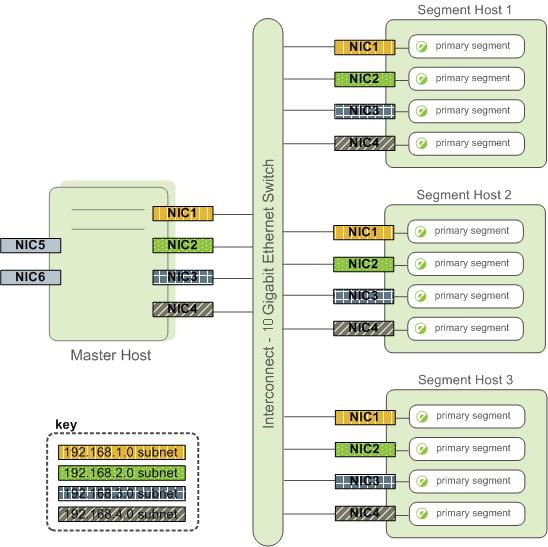
Switch Configuration
When using multiple 10 Gigabit Ethernet switches within your LightDB-A Database array, evenly divide the number of subnets between each switch. In this example configuration, if we had two switches, NICs 1 and 2 on each host would use switch 1 and NICs 3 and 4 on each host would use switch 2. For the coordinator host, the host name bound to NIC 1 (and therefore using switch 1) is the effective coordinator host name for the array. Therefore, if deploying a warm standby coordinator for redundancy purposes, the standby coordinator should map to a NIC that uses a different switch than the primary coordinator.
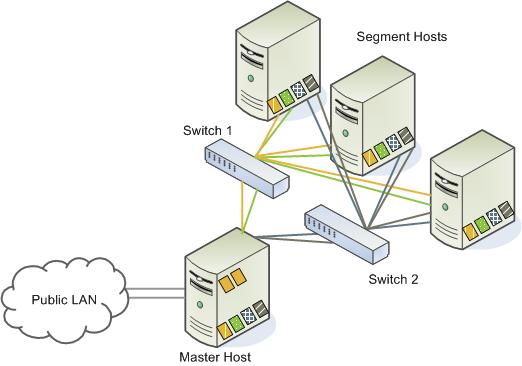
ETL Hosts for Data Loading
LightDB-A supports fast, parallel data loading with its external tables feature. By using external tables in conjunction with LightDB-A Database’s parallel file server (gpfdist), administrators can achieve maximum parallelism and load bandwidth from their LightDB-A Database system. Many production systems deploy designated ETL servers for data loading purposes. These machines run the LightDB-A parallel file server (gpfdist), but not LightDB-A Database instances.
One advantage of using the gpfdist file server program is that it ensures that all of the segments in your LightDB-A Database system are fully utilized when reading from external table data files.
The gpfdist program can serve data to the segment instances at an average rate of about 350 MB/s for delimited text formatted files and 200 MB/s for CSV formatted files. Therefore, you should consider the following options when running gpfdist in order to maximize the network bandwidth of your ETL systems:
- If your ETL machine is configured with multiple network interface cards (NICs) as described in Network Interface Configuration, run one instance of
gpfdiston your ETL host and then define your external table definition so that the host name of each NIC is declared in theLOCATIONclause (seeCREATE EXTERNAL TABLEin the LightDB-A Database Reference Guide). This allows network traffic between your LightDB-A segment hosts and your ETL host to use all NICs simultaneously.
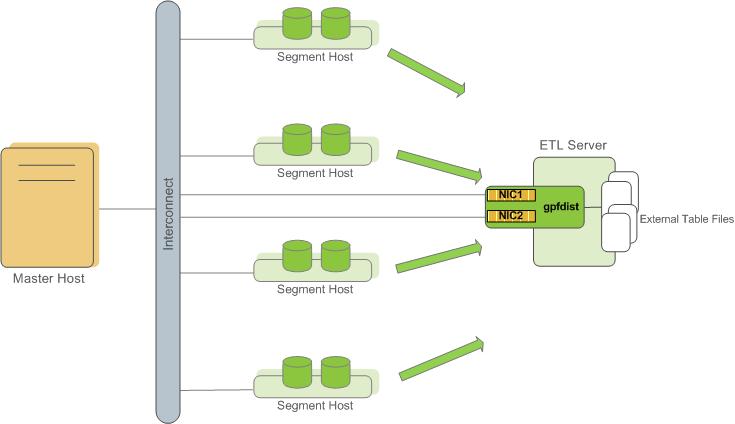
- Run multiple
gpfdistinstances on your ETL host and divide your external data files equally between each instance. For example, if you have an ETL system with two network interface cards (NICs), then you could run twogpfdistinstances on that machine to maximize your load performance. You would then divide the external table data files evenly between the twogpfdistprograms.
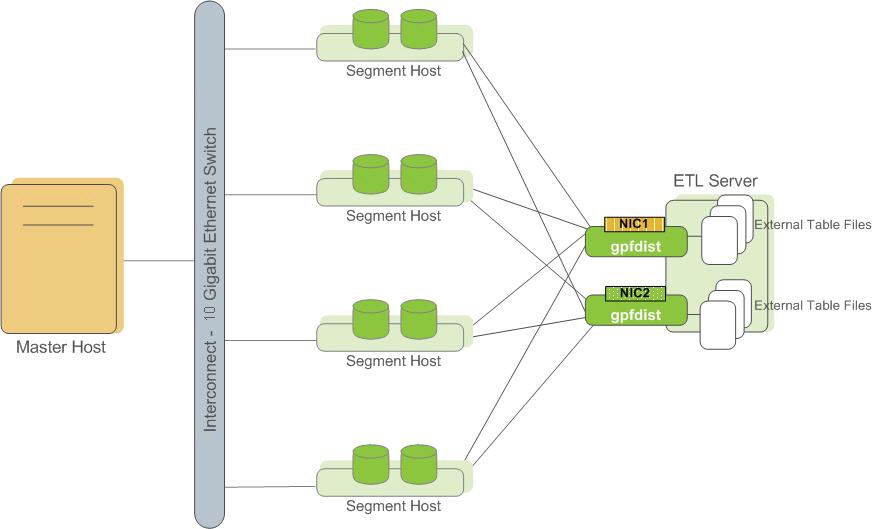
Parent topic: Introduction to LightDB-A
VMware LightDB-A Performance Monitoring
VMware LightDB-A Command Center is an optional web-based performance monitoring and management tool for LightDB-A Database. Administrators can install Command Center separately from LightDB-A Database.
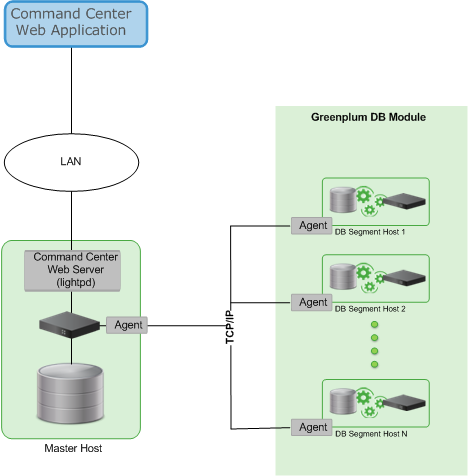
Parent topic: Introduction to LightDB-A